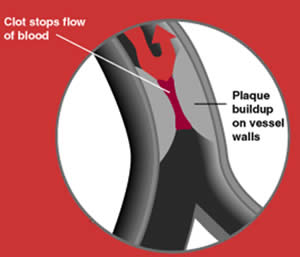Difference between Heart Attack and Cardiac Arrest
Key Difference: Heart attack is when the blood flow to the heart is restricted causing the heart cells to die. The lack of blood flow is caused by a partial blockage to the a coronary artery causing the rupture of a vulnerable atherosclerotic plaque, an unstable collection of lipids and white blood cells in the wall of an artery. Cardiac Arrest is a heart condition where the heart does not contract properly, thereby failing to effectively circulate blood to the other organs. Cardiac arrest is brought on by irregular beating of the heart that causes it to stop supplying blood flow to the other organs, including the brain.
Heart Attack and cardiac arrest are two heart conditions that are pretty serious in nature. These conditions can be confusing for many people that are not well-versed with medical terms. Both of these conditions are related to the heart and the smooth running of it. The moment the heart stops performing properly, it automatically affects all the other organs. Heart Attack and Cardiac Arrest may sound similar and an also have similar symptoms, but they are two different conditions. In many cases, heart attacks are one of the causes of cardiac arrest. These both conditions require emergency responses and can lead to the loss of life if not dealt with speed and accuracy.

Heart attack is when the blood flow to the heart is restricted causing the heart cells to die. The lack of blood flow is caused by a partial blockage to the a coronary artery causing the rupture of a vulnerable atherosclerotic plaque, an unstable collection of lipids and white blood cells in the wall of an artery. Heart attack is also known as Myocardial infarction (MI) or acute myocardial infarction (AMI). The reduced blood flow results in restricted oxygen supply to the heart, which manifests itself as severe pain and discomfort in the chest. This pain can then spread to the shoulders, arms, neck, jaw, or back.
Let’s simplify what happens during a heart attack. Plague made up of calcium, proteins and inflammatory cells cover the lining of the arteries, where they are deposited when the blood flows to the heart. The plague lining becomes hard after constant deposition and then cracks. The ruptured plague gets built up in the arteries blocking the blood from going through to the heart valves. The oxygenated blood never reaches the heart, causing the heart to become starved. This is similar to when a person not being able to get oxygen or air. The cells that do not receive the oxygen start to die. Note: This is permanent damage; the cells do not automatically rejuvenate. The dying of the cells manifests itself as pain and discomfort in the chest. Another reason for a heart attack could be a severe spasm or tightening of a coronary artery. The spasm cuts off blood flow through the artery, which leads to an attack. These spasms can occur in coronary arteries that do not have plaque built up.
Symptoms of a heart attack include: Discomfort (chest, arm, below the breastbone, back, jaw, throat and/or arm), pressure, heaviness, pain (chest, arms and/or below the breastbone), sweating, nausea, vomiting, shortness of breath, irregular heartbeats. During a heart attack, the symptoms last 30 minutes. Some people may also have a heart attack without any symptoms; these are known as ‘silent’ heart attacks and are common in diabetic patients.
 Cardiac Arrest is a heart condition where the heart does not contract properly, thereby failing to effectively circulate blood to the other organs. Cardiac arrest is brought on by irregular beating of the heart that causes it to stop supplying blood flow to the other organs, including the brain. Cardiac arrest is also known as cardiopulmonary arrest or circulatory arrest. The heart has an internal electrical system that allows it to control the rhythm of the heart; any changes to the rhythm can cause the heart to either beat too fast, too slow or stop beating completely. These changes are known as arrhythmias. The lack of blood flow leaves the other organs starved for oxygenated blood. The lack of oxygen to the brain causes the person to faint. If the person does not receive help during the first five minutes of fainting, it can result in permanent damage to the brain.
Cardiac Arrest is a heart condition where the heart does not contract properly, thereby failing to effectively circulate blood to the other organs. Cardiac arrest is brought on by irregular beating of the heart that causes it to stop supplying blood flow to the other organs, including the brain. Cardiac arrest is also known as cardiopulmonary arrest or circulatory arrest. The heart has an internal electrical system that allows it to control the rhythm of the heart; any changes to the rhythm can cause the heart to either beat too fast, too slow or stop beating completely. These changes are known as arrhythmias. The lack of blood flow leaves the other organs starved for oxygenated blood. The lack of oxygen to the brain causes the person to faint. If the person does not receive help during the first five minutes of fainting, it can result in permanent damage to the brain.
Cardiac arrest can be a cause of Coronary heart disease, cardiac abnormalities such as cardiomyopathy, cardiac rhythm disturbances, hypertensive heart disease, congestive heart failure, etc., trauma, overdose, drowning, smoking, obesity, lack of physical exercise, etc. Cardiac arrest brought on suddenly is known as Sudden Cardiac Arrest (SCA) and causes the heart to stop beating completely. Cardiac arrest differs from heart attack as in a heart attack, the heart does not receive the oxygenated blood and all the while it continues to beat and pump until the cells die completely. In cardiac arrest, the heart itself stops beating, though it still receives constant supply of oxygenated blood.
Symptoms of cardiac arrest include fainting and loss of pulse or heartbeat. The person stops breathing as the heart no longer pumps. The person that suffers a cardiac arrest must receive quick cardiopulmonary resuscitation (CPR) to keep the heart pumping the brain from losing cells. The longer it takes the person to receive help, the more chances that they may have loss of memory, brain damages or less chances of survival. Defibrillation (or shocking the heart) is another way to revive the heart. Implantable cardioverter-defibrillators (ICDs) and pacemakers are used to ensure that the person does not suffer from another cardiac arrest episode in the event of arrhythmia.
Image Courtesy: skepticalraptor.com, ece.uc.edu









Add new comment